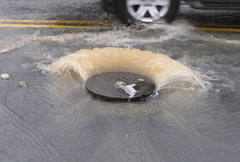Smart Sewers/Note on Emerging Science
Air Date: Week of July 11, 2008

The effects of combined sewer overflow in West Haven, Connecticut. (Photo: Christopher Zurcher/CTEnvironmentalHeadlines.com)
Mechanized sewers may be the answer to storm overflow getting into nearby water bodies. Jessica Ilyse reports.
Transcript
GELLERMAN: It’s Living on Earth. I’m Bruce Gellerman. Just ahead – how about a nice hot cup of genetically modified joe? But first this note on emerging science from Jessica Ilyse Smith.
SMITH: What happens when crisis strikes the sewers?
[MUSIC: Teenage Mutant Ninja Turtles Theme Song]
SMITH: No, it’s not the Teenage Mutant Ninja Turtles to the rescue, but engineers working to save our waterways from sewage overflows.
[SCIENCE NOTE THEME]
SMITH: Researchers at both Purdue and Notre Dame University have teamed up with the company, EmNet, to create a network of mechanized sewers for the city of South Bend, Indiana. Their goal is to reduce overflow of raw sewage into nearby waterways during heavy rain. Overflow is a problem for nearly 770 cities in the U.S., where everything from toilet waste to street-water runoff is combined in one sewer system. This method leaves little capacity for water build-up during a large storm.
Combined sewer overflows are problematic for both aquatic ecosystems and humans, who use lakes and rivers for recreation. Raw sewage released into waterways may contain E. coli, as well as other disease-causing bacteria and parasites. The EPA estimates there are at least 40,000 such overflows each year.

The effects of combined sewer overflow in West Haven, Connecticut. (Photo: Christopher Zurcher/CTEnvironmentalHeadlines.com)
Now, that’s Turtle Power!
That's this week's note on emerging science; I'm Jessica Ilyse Smith.
Living on Earth wants to hear from you!
Living on Earth
62 Calef Highway, Suite 212
Lee, NH 03861
Telephone: 617-287-4121
E-mail: comments@loe.org
Newsletter [Click here]
Donate to Living on Earth!
Living on Earth is an independent media program and relies entirely on contributions from listeners and institutions supporting public service. Please donate now to preserve an independent environmental voice.
NewsletterLiving on Earth offers a weekly delivery of the show's rundown to your mailbox. Sign up for our newsletter today!
 Sailors For The Sea: Be the change you want to sea.
Sailors For The Sea: Be the change you want to sea.
 The Grantham Foundation for the Protection of the Environment: Committed to protecting and improving the health of the global environment.
The Grantham Foundation for the Protection of the Environment: Committed to protecting and improving the health of the global environment.
 Contribute to Living on Earth and receive, as our gift to you, an archival print of one of Mark Seth Lender's extraordinary wildlife photographs. Follow the link to see Mark's current collection of photographs.
Contribute to Living on Earth and receive, as our gift to you, an archival print of one of Mark Seth Lender's extraordinary wildlife photographs. Follow the link to see Mark's current collection of photographs.
 Buy a signed copy of Mark Seth Lender's book Smeagull the Seagull & support Living on Earth
Buy a signed copy of Mark Seth Lender's book Smeagull the Seagull & support Living on Earth

